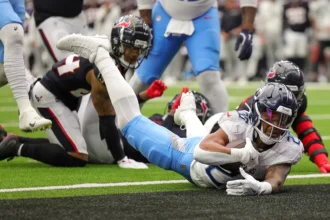KL Rahul batting for India during a high-stakes match is a study in poise — head still, eyes level, wrists soft but decisive. He is not the loudest in the Indian dressing room, nor the one with the most flamboyant celebrations. Yet, over the past decade, Kannaur Lokesh Rahul has built a career defined by elegance, adaptability, and a quiet resilience that has earned him the moniker of “The Silent Warrior”.
Born on 18 April 1992 in Bangalore and raised in Mangalore, Karnataka, Rahul’s story is one of meticulous craftsmanship — from his early days in local clubs to becoming one of the most dependable all-format players India has produced in recent years. For a deeper look at his numbers across formats, you can explore the detailed KL Rahul stats covering his ODI, T20, IPL, and Test performances.
Biography and Early Cricket Career
Rahul was born into an academically inclined family. His father, a professor, famously named him “Rahul” after mistakenly believing it was Sunil Gavaskar’s son’s name. Growing up in Mangalore, he began formal cricket training at the age of 10, showing early promise in local club cricket.
By 18, Rahul moved to Bangalore, enrolling at Jain University to balance education with an increasingly demanding cricket schedule. His domestic rise was swift: debuting in first-class cricket for Karnataka in 2010–11, representing India at the 2010 Under-19 World Cup, and then breaking through spectacularly in the 2012–13 Ranji Trophy as the tournament’s top scorer.
In 2013–14, he piled up 1,033 first-class runs — the second-highest tally in India — and etched his name into Karnataka’s cricketing history with a triple century (337) in early 2015. The avalanche of runs earned him a Test call-up for the 2014–15 Australia tour.
Rise in Domestic and International Cricket
Rahul’s Test debut came on Boxing Day 2014 in Melbourne — a nervy start with scores of 3 and 1. But a promotion to open in Sydney brought redemption: a serene 110, his maiden Test hundred, in only his second match. It was the first sign of a player who thrives on second chances.
Over the next two years, Rahul made hundreds in Sri Lanka and the West Indies, converting his first three Test fifties into centuries — an “all-or-nothing” trait that would both define and challenge him. At home, he came agonisingly close to a double ton, scoring 199 against England in Chennai (2016).
His white-ball journey was no less dramatic. Rahul debuted in ODIs in June 2016 with an unbeaten 100 against Zimbabwe — the first Indian to score a century on ODI debut. Just weeks later, he smashed a T20I hundred (110* vs West Indies), joining the elite group of players with tons in all three formats.
By 2018–19, he was a white-ball mainstay, producing highlights such as a T20 century against England at Old Trafford (2018) and consistent contributions in the 2019 ODI World Cup. His Test career, however, saw fluctuations, with inconsistent runs leading to occasional omissions.
Playing Style and Technique
Technically sound and aesthetically gifted, Rahul’s batting blends classical orthodoxy with modern fluency. A protégé of Rahul Dravid, he mirrors his mentor’s composure and adaptability, shifting gears from watchful defence in Tests to free-flowing aggression in T20s.
A hallmark of his career has been versatility. Rahul has opened in T20Is, anchored the middle order in ODIs, and even kept wickets to balance team combinations. His cover drives and pull shots are often cited among the most graceful in the modern game.
Criticism, however, has followed him — particularly in T20 cricket, where some pundits argue his strike rate is conservative for the format. In IPL 2024, for instance, he scored 520 runs at 136.1 — effective but slower than many peers. In Tests, too, he has often either made big hundreds or fallen cheaply, with little in between.
Injuries disrupted his 2022 season — including sports hernia surgery — and cost him a Test place in early 2023. But his comeback at the Asia Cup 2023 was emphatic: 111* against Pakistan in the Super Four.
The 2023 ODI World Cup became a defining stage. A heroic 97* against Australia rescued India from 2/3, and a blistering 111 off 63 balls against the Netherlands broke the record for fastest World Cup century by an Indian. He finished the tournament with 452 runs at 75.33, top-scoring in the final with 66 in a losing cause.
In 2023–24, Rahul added an ODI series win in South Africa as captain, a home Test century against the Proteas, and another measured comeback in late 2024 with a match-winning 68* against Bangladesh.
In July 2025, Rahul scored a century at Lord’s — his second at the venue — becoming only the second Indian after Dilip Vengsarkar to achieve the feat. His calm, unbeaten knocks in the 2025 ICC Champions Trophy semi-final and final were pivotal to India’s triumph.
Leadership Roles
Rahul has captained India in all formats in stand-in roles, including Tests in South Africa (2022) and multiple ODI series. His leadership style mirrors his batting — calm, measured, and tactically aware.
In the IPL, he captained Punjab Kings (2020–21) and then the Lucknow Super Giants (2022–24), leading both to playoff appearances but also facing scrutiny over strike rates. Ahead of IPL 2025, he joined Delhi Capitals, bringing with him a wealth of leadership experience.
Key Milestones
- First Test Century (2015)– 110 at Sydney.
- Triple Century in Ranji Trophy (2015)– 337 for Karnataka.
- ODI Debut Hundred (2016)– 100* vs Zimbabwe.
- T20I Hundred (2016)– 110* vs West Indies.
- Fastest IPL Fifty (2018)– 14 balls vs Delhi.
- Lord’s Hundreds– 129 (2021) & 100 (2025).
- Fastest World Cup Hundred by an Indian– 62 balls vs Netherlands (2023).
Reputation and Cultural Influence
Rahul is respected within the team as a steadying influence — a player who keeps the dressing room calm and does the “hard jobs” without fuss. His partnership with coach Rahul Dravid has reinforced his work ethic and mental discipline.
Fans call him “KLassy Rahul”, admiring his style and clutch performances. His 2023 marriage to actress Athiya Shetty brought celebrity attention, but Rahul has maintained a low public profile, prioritising cricket over glamour.
Media and Public Image
The media narrative around Rahul oscillates between acclaim for his match-winning poise and criticism for inconsistency or tempo in limited-overs cricket. His 2023 World Cup final strike rate, for instance, drew online trolling despite his overall stellar tournament.
Rahul’s dignified silence in the face of criticism — most notably during his 2022–23 slump — has only reinforced his “Silent Warrior” persona. The infamous 2019 “Koffee with Karan” controversy was a turning point in his public approach, making him more guarded and mature.
Conclusion
KL Rahul’s career is a masterclass in perseverance and adaptability. He has endured injuries, form slumps, and intense public scrutiny — yet each time, he has returned with innings that shape India’s biggest victories.
In a cricket culture that celebrates the loud and flamboyant, Rahul’s quiet steel is a refreshing reminder that warriors do not always roar — sometimes, they simply bat with elegance, absorb the pressure, and walk away having won the battle.
Your Daily Dose of Sports – Follow Jeetwin Sports for expert opinions, breaking updates, and all the stories shaping Indian and global sports.

















